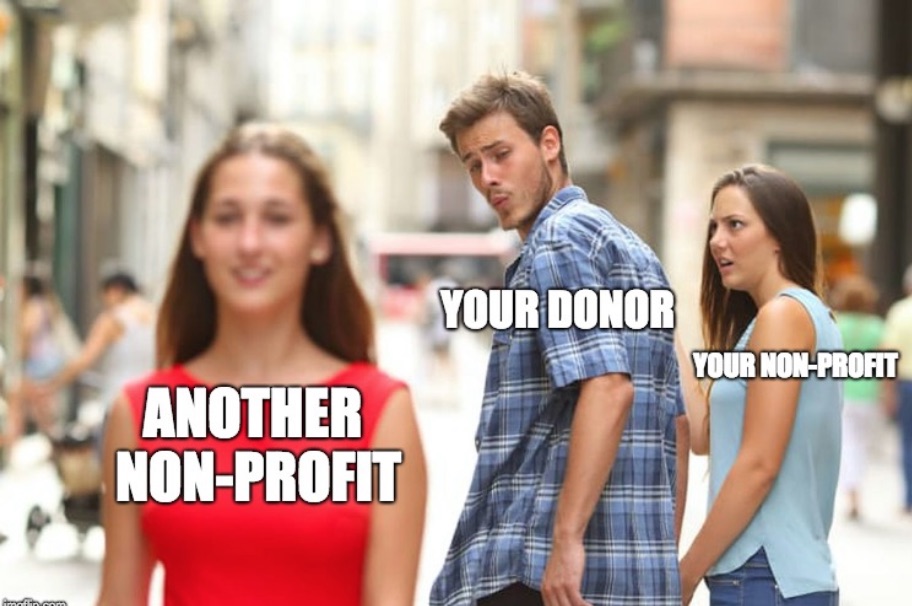One of the Oneicity team’s young guns sent me this nonprofit version of The Distracted Boyfriend meme he’d created. He called it the Distracted Donor. I laughed out loud.  We were in the middle of a multi-day trip and client meeting. I was tired and a wee bit stressed. The laugh felt good. I showed his “Distracted Donor” meme to Hoots to share the laugh. She looked at it and said, “I don’t get it.”
We were in the middle of a multi-day trip and client meeting. I was tired and a wee bit stressed. The laugh felt good. I showed his “Distracted Donor” meme to Hoots to share the laugh. She looked at it and said, “I don’t get it.”
“It’s the nonprofit version of “The Distracted Boyfriend.” I said.
“The what?”
“You know the ‘Distracted Boyfriend’ meme. . . “ No recognition. I plowed on. “It’s everywhere. . . you’ve seen it. It says what I was talking about this morning in the meeting. You know, how you have to stay in front of your donors with your message.” She looked at me like I was speaking Latin. “You’re on Facebook and Instagram,” I said trailing off. “You’ve seen it” I tried, losing steam as I went. “It’s a meme.” I’m sorry to admit I really said that again as if I hadn’t already mentioned “meme” 17 times in this two-minute long conversation.
She ended the conversation with, “I’ve never seen it.”
Strange.
And moderately disturbing.
Later that next morning our team was having coffee and getting ready to load up for that day’s meetings. I remembered the meme and showed it to one of the other Oneicity team. She’s young, digitally savvy, culturally aware and would redeem my disconnected moment with Hoots.
“Look at this,” I said launching into my pitch with inordinate pride. “Remember when we were talking about having to keep our message in front of donors?” I showed her Distracted Donor. “Isn’t that hilarious?” I had learned from my previous attempt to connect this awesome meme with my audience. The setup would help.
Long pause as she studied the meme.
“I don’t get it.” She said.
And in that moment I had a chilling realization. I was making a mistake I caution clients to avoid. I assumed that because something was familiar, impactful or logical to me, it would be to everyone else.
It’s one way smart people make dumb mistakes.
It’s why good leaders kill direct mail even though it’s working.
It’s why leaders convince themselves that all of their donors are just like them.
And it’s why I thought everyone would find the meme hilarious and insightful. And I was wrong.
I was reminded, again, that I’m not everyone.
And you’re not either.
You could label this mistake a variety of ways. You’ll know it as one of the Cognitive Biases. It’s fits neatly as Confirmation Bias. And it’s as deadly as the other cognitive biases to good decision making. And, sadly, I was totally unaware of my moment of Confirmation Bias.
Learn from me. Just because you don’t like something, doesn’t mean it’s a bad idea. And just because you’re sure everyone’s heard of it. . . (well you know how it goes).
Be careful with your certainty that you know your audience. It’s one of the reasons it’s important to have someone on the outside looking in.
Oh, I’m still right about the need to keep your message in front of your donors. In our world of saturated media (traditional media and social media), it’s more important than ever that you ignore any of those voices who tell you otherwise.
Feel free to email me your tales of Confirmation Bias. Or email me with how hilarious you think the Distracted Donor is (if you’ve never heard of it, I don’t need to know).
I’m grateful to share the journey with you.
st

